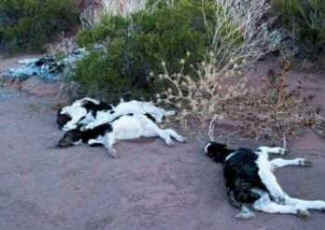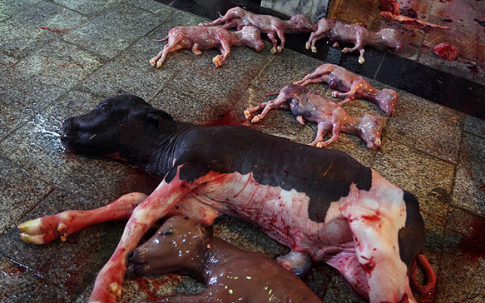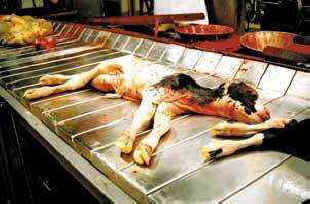Pregnancy at Slaughter: What Happens to the Calves?
ANIMAL RIGHTS - VEGETARIANISM, 15 Jun 2015
Stephanie Ernst, All Creatures – TRANSCEND Media Service
Part 1
What happens when a cow is pregnant at the time of slaughter? I almost wish I didn’t know. From the calves experiencing their mother’s death from inside her, while they too suffer or die their own terrible death, to live calves being cut from their dead mother’s womb, so that their blood can be drained for science while they’re still alive–it’s all horrific, and none of it is ever talked about, even though it’s a part of the dairy and beef industries and a part of how people get their “finest” leather.
By accident a few months ago, I ended up watching a video of a pregnant cow already stunned and hung upside down–and the video showed an apparently almost-full-term calf struggling inside and against the mother’s body, kicking in desperation, dying a horrible death inside the womb. Later came the image of that young calf’s presumably dead body tossed into a bin (though it seems still live calves are often tossed as well).
This is one particular horror I’d previously failed to consider. Dairy cows especially (more than beef cows, that is, given that dairy cows are kept perpetually pregnant) may go to slaughter while pregnant if they become unprofitable before giving birth or if the producers decide to kill a bunch of cows even more prematurely than usual to save money when demand is down. And so while workers stun them, hang them upside down, cut open their throats to let the blood from their body drain out, cut off their legs, and pull off their skin, all that time, there is a calf inside them, fighting and dying a horrifying death. How soon in the process the calf inside dies likely varies according to how developed he or she was and how fast the slaughter process moves. In an “efficient” slaughterhouse, the calf could still be dying–dying but still living, still suffering terribly–at the time of her mother’s dismemberment and disembowelment.
A UK survey in the 1990s at one slaughterhouse found that, “of the slaughtered cows, 23.5 per cent were pregnant and 26.9 per cent of these were in the third trimester.” 23 percent were pregnant. That’s a lot. One percent–or even 1 calf–would be too many.
But it gets worse. In addition to the trauma of still being alive inside their mothers during the latter’s death, fetal calves may also be cut from their mother’s womb while still alive–so that their blood can be drained for use in science, without anesthesia.
Part 2
 Two questions: (1) Do you know where leather, especially “high-quality” leather, comes from? and (2) Do you know what fetal bovine serum or fetal calf serum is and what its connection to dairy, “meat,” and leather is? For most, the answer to both–especially to number 2–is no. So here are the answers.
Two questions: (1) Do you know where leather, especially “high-quality” leather, comes from? and (2) Do you know what fetal bovine serum or fetal calf serum is and what its connection to dairy, “meat,” and leather is? For most, the answer to both–especially to number 2–is no. So here are the answers.
When pregnant cows go to slaughter, in addition to the trauma of still being alive inside their mothers during the latter’s death, fetal calves may also be cut from their mother’s womb while still alive–so that their hearts can be punctured and their blood drained for use in science, without anesthesia. From the Australian Association for Humane Research:
After slaughter and bleeding of the cow at an abattoir, the mother’s uterus containing the calf fetus is removed during the evisceration process (removal of the mother’s internal organs) and transferred to the blood collection room. A needle is then inserted between the fetus’s ribs directly into its heart and the blood is vacuumed into a sterile collection bag. This process is aimed at minimizing the risk of contamination of the serum with micro-organisms from the fetus and its environment. Only fetuses over the age of three months are used otherwise the heart is considered too small to puncture.
The previous source was hesitant to say definitively whether (or how often) the calves are still alive during this process. But according to the following account (PDF), whether the calf is alive is not so questionable (emphasis mine):
The heart of the bovine fetus is functioning during the bleeding process via cardiac puncture. . . . The fetal heart must be beating in order to obtain an adequate harvest of fetalbovine serum production by means of cardiac puncture. Blood coagulates immediately upon death [17, 18]. . . .
It might be thought that the fetus dies at approximately the same time as its mother due to lack of oxygen supply to the placenta. However, since long it is known that the neonates and fetuses of animals are (very) resistant to hypoxia/ anoxia (lack of oxygen). . . .
The fact that the fetal heart is functioning during the cardiac puncture, indicates the fetus is still alive at the moment of the cardiac puncture – and therefore may experience pain because of the needle inserted into its heart, and because of terminal bleeding. As the fetus is never anaesthetised or stunned prior to the performance of a cardiac puncture for FBS harvest, it can be stated that FBS harvest by means of the method described above, represents an ethical problem which needs close consideration (→ 5, 6).
The author of this same thesis elsewhere quotes a former inspector for the U.S. Department of Agriculture, Gene Erickson, as confirming this: “For all practical purposes, a fetal calf’s heart must be beating to obtain an adequate harvest for fetal calf serum production.” And I don’t understand why we would hesitate for a second to assume they suffer–if they’re alive, why wouldn’t this cause suffering? Think about it in human terms (because we are similar in all the ways that matter here). A woman who is 8 months pregnant dies. As she is dying or just after she dies, you cut the fetus out of her. You lay the baby on a cart, jab a needle into her heart, and start draining her blood out. Do we really need to debate whether that would cause the baby pain and suffering?
This is all pretty terrible, right? But anyone who is still eating animals, consuming dairy, and purchasing leather is funding these nightmarish practices. The dairy industry is cruel. Leather is cruel. They are as cruel as, if not more cruel than, the “meat” industry.
In fact, though no leather is free of attachments to cruelty, suffering, and death, the skin of these unborn calves who died these atrocious deaths is considered to make especially soft and “luxurious” leather and is valued for glove-making, for example. And of course, the unborn calves aren’t the only calves skinned for human fashion. The calves killed after birth by the dairy industry–veal calves–are skinned for the same purpose. The skins peeled off the bodies of both tortured veal calves and tortured unborn calves fetch a high price precisely because the babies’ skin is so soft and unblemished–that is, precisely because it is the skin of newborns. Calfskin is just what it says it is.
Vegetarian and meat-eating readers, I hope that after reading this post and the previous one, you’re rethinking your resistance to giving up not only flesh and eggs but dairy too. Every time we think we know about all the cruelties involved, we learn about another dark and horrible aspect to animal agriculture. Who wants to be a part of–who wants to financially support–what happens to these calves? How do we justify it when we are merely choosing to be a part of it, when we can so easily choose not to be a part of it? (If you’ve not been convinced by words alone, see this graphic image gallery at Viva!. I can’t imagine anyone seeing it and not being profoundly affected.)
And in addition to getting cruelty out of your diet, the next time you’re eyeing a pair of leather gloves or shoes or a leather bag or a leather wallet, you might ask yourself how much suffering, how much torture, how many lives, rather than how many dollars. Maybe you’ll picture these dead calves rather than yourself in the accessories made from their suffering, from their skins. And perhaps you’ll walk away rather than to the checkout counter.
I didn’t intend for there to be a third part to the posts I wrote a couple months ago about what happens to pregnant dairy cows–and the calves they’re carrying–when the industry is done with them, but then in recent days, a video surfaced. And of all the horrible, horrifying videos I have seen over the years, this has to be one of the absolute worst.
On the background that the mother cow is still periodically kicking while bleeding out, as the calf who was brutally cut from her womb and laid out on the floor just feet away struggles and cries out for his mother. Their blood–so much blood–pools together after his throat is slit too, as they die horrific deaths together, both mother and baby helpless witness to the other’s suffering and violent death. For dairy.
It doesn’t matter if this particular video wasn’t shot in your own country of residence. The unspeakable cruelties such as these do not know borders. They happen everywhere.
This (and this and this) is dairy milk. And milk chocolate. And dairy cheese. And dairy ice cream. This horror, my friends, is dairy.text
Go to Original – all-creatures.org
DISCLAIMER: The statements, views and opinions expressed in pieces republished here are solely those of the authors and do not necessarily represent those of TMS. In accordance with title 17 U.S.C. section 107, this material is distributed without profit to those who have expressed a prior interest in receiving the included information for research and educational purposes. TMS has no affiliation whatsoever with the originator of this article nor is TMS endorsed or sponsored by the originator. “GO TO ORIGINAL” links are provided as a convenience to our readers and allow for verification of authenticity. However, as originating pages are often updated by their originating host sites, the versions posted may not match the versions our readers view when clicking the “GO TO ORIGINAL” links. This site contains copyrighted material the use of which has not always been specifically authorized by the copyright owner. We are making such material available in our efforts to advance understanding of environmental, political, human rights, economic, democracy, scientific, and social justice issues, etc. We believe this constitutes a ‘fair use’ of any such copyrighted material as provided for in section 107 of the US Copyright Law. In accordance with Title 17 U.S.C. Section 107, the material on this site is distributed without profit to those who have expressed a prior interest in receiving the included information for research and educational purposes. For more information go to: http://www.law.cornell.edu/uscode/17/107.shtml. If you wish to use copyrighted material from this site for purposes of your own that go beyond ‘fair use’, you must obtain permission from the copyright owner.
Read more
Click here to go to the current weekly digest or pick another article:
ANIMAL RIGHTS - VEGETARIANISM:


